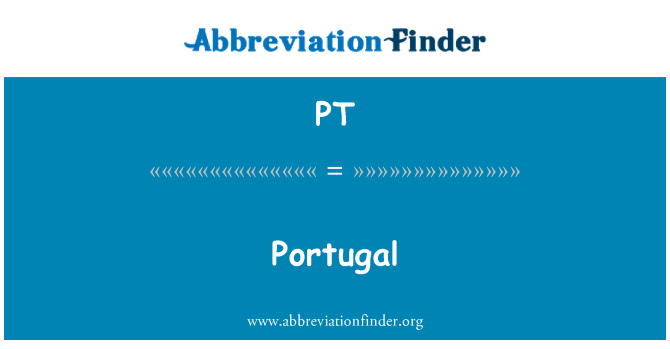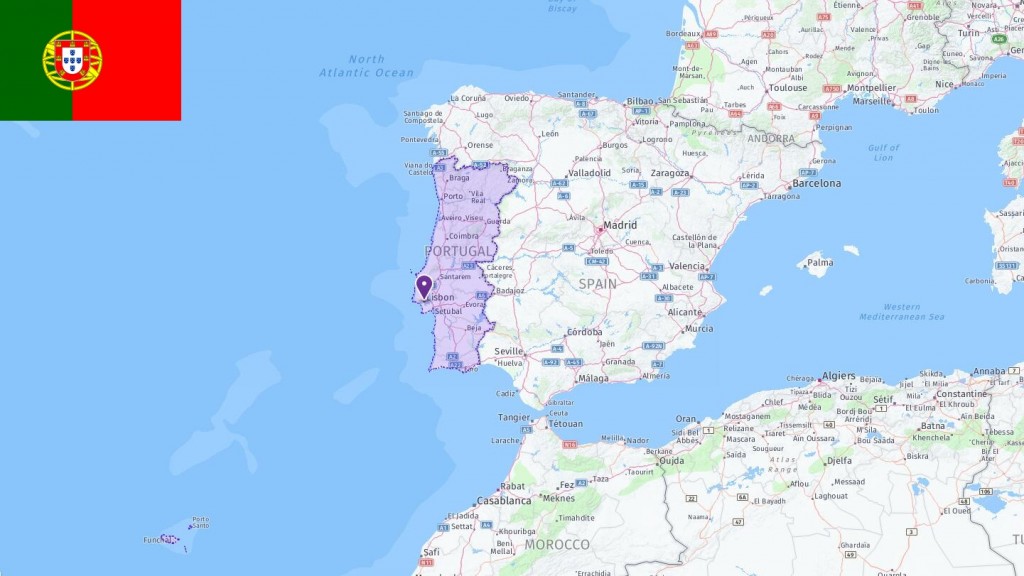PT is the abbreviation for Portugal, the 109th largest country in the world. Officially the Portuguese Republic, Portugal is a country located in southern Europe, bordering Spain. Lisbon is the capital city of Portugal. Major cities include Lisbon (population: 517,791), Porto (population: 249,622), Amadora (population: 178,847), Braga (population: 121,383), Setúbal (population: 117,099), Coimbra (population: 106,571), Queluz (population: 103,388), Funchal (population: 100,836), Cacém (population: 93,971), and Vila Nova de Gaia (population: 70,800).
Country Profile
- Capital: Lisbon
- Language: Portuguese
- Area: 92,212 km2
- Population: 10,276,608
- Currency: Euro (€) (EUR)
- Time zone: UTC−1
- Calling code: 351
- ISO 2-Letter Abbreviation: PT
- UN 3-Letter Abbreviation: PRT
- Internet TLD: .pt
- State Government Website: http://portugal.gov.pt
List of Portugal Acronyms
The most commonly used abbreviations about Portugal are PT which stands for Portugal and EUR which means Euro (Portugal currency). In the following table, you can see all acronyms related to Portugal, including abbreviations for airport, city, school, port, government, and etc.

Geography
The northern areas of Portugal are characterized by mountainous areas and hilly terrain. The highest peaks of the Serra da Estrela mountain range reach 2000 meters above sea level. Further south in the country the landscape is characterized by hills and plains. These two different landscapes are separated by the river Tejo, which flows from Spain in the east, towards the Atlantic in the west. Portugal has a typical Mediterranean climate with hot, dry summers and humid, colder winters. The country has some of the highest average temperatures in Europe in the southern coastal regions, while in the northern mountainous regions it can drop to ten minus degrees in winter.
The biggest environmental challenges in Portugal are pollution of water and air from industrialization. The clean-up and remediation of contaminated areas has been time-consuming for the country.
History
Celtic tribes settled in Portugal about 500 BCE. The area was further incorporated into the Roman Empire ca. 200 BCE After the fall of the Roman Empire, the country became subject to gliders and Visigoths until the beginning of the 7th century AD, when Arabs occupied the Iberian Peninsula. The Arab government lasted until 1128, when Portugal crowned its first king. Over the next centuries, Portugal grew into one of Europe’s richest countries, a world leader in science and shipping. Portuguese seafarers established colonies and trading stations in distant corners of the world and brought enormous wealth home. In the middle of the 16th century, the country ruled one of the world’s largest empires. The recession began in 1580, when Spain invaded Portugal and in the following years several Portuguese colonies were conquered. After new independence in 1668, the country continued to lose colonies.
Throughout the 19th century Portugal was characterized by political unrest, the coup and economic downturns. Protests and riots led to the monarchy being overthrown in 1910. The riots continued as the republic was proclaimed, and after a military coup in 1926, the country entered a dictatorship that lasted until the revolution in 1975. As democracy was introduced, the country lost its last colonies in Africa. Since then, Portugal has had a relatively stable democracy.
Society and politics
Portugal is a parliamentary-democratic republic. Power is shared between the president, who is elected every five years, and the prime minister, who heads the government. The president is the head of state, but shares power equally with the prime minister.
There are two parties that dominate in politics: the Socialist Party and the Social Democratic Party, which despite the name is a bourgeois party.
The country’s policies are strongly influenced by the aftermath of the global financial crisis in 2008. Unemployment rose sharply, which put great pressure on the state and the public sector. The social upheaval led to large sections of the population being pushed into poverty, without the opportunity to repay debt or loans. Public services such as the health, elderly care and education sectors also had to resort to large cuts, which increased the dissatisfaction of the population.
Portugal has some of the world’s most liberal drug laws. Since 2001, the use of drugs has been decriminalized, instead focusing heavily on substance abuse, care and preventive measures. The country also has good rights for sexual minorities. Since 2010, same-sex couples can enter into marriage. However, Portugal struggles to achieve equality in society. Women are under-represented in the labor market, and on average earn less than men.
Economics and Commerce
Since the dictatorship ended in the 1970s, Portugal’s economy has undergone a modernization process in which agriculture has declined sharply in favor of growing trade and services industry. Despite this, the country is still one of the least competitive in the EU. Portugal has large seas and cooperates closely with the EU on the management of its maritime economic zone.
Portugal was one of the countries in the euro zone that was hit hardest by the global financial crisis in 2008. In 2011, the country had to borrow large loans from the International Monetary Fund, the EU and the European Central Bank. The savings measures that were implemented were not popular among the population, but contributed to the country’s economy not collapsing completely. Since 2014, unemployment has gone down, the budget deficit has fallen, and government debt has fallen. However, the social and economic differences have increased. The richest fifth of the population earns almost six times as much as the poorest fifth. Differences between the rich southern region and the poorer northern region have also increased.
View this article in other languages:
Deutsch – Français – 繁體中文


